Innovative Building Technology
Perspectives on tomorrow’s construction

Automobile and aircraft construction, even mechanical engineering are no longer conceivable without computerised production methods.The key word is Industry 4.0. The construction industry is struggling to catch up with this development. So it’s a bit too early to speak of Construction 4.0.
Most buildings are still being erected with methods that were up-to-date 50 years ago. Initial attempts – for instance in Japan – to build entire houses with robots remained stuck at the experimental stage and buildings printed out with 3-D printers have also not been all that convincing.
But the latest building boom and the insight that action is needed especially where construction is concerned, as it burdens the environment, are currently spurring researchers in search of new building materials and construction methods. Timber construction is reinventing itself from crude carpentry to a high-tech industry. In cement construction, steel is being replaced by textile reinforcements or carbon fibre mats. In this way, construction can become significantly leaner and lighter. A research group at the TU Dresden around Manfred Curbach, director of the Instituts für Massivbau / Institute of Concrete Structures, is at the leading edge of the development of this innovative building material. With the use of high-performance carbon concrete composite, CO2 emission during construction can be reduced and CO2 can even be bound. Moreover, sand consumption – now a problem in a number of the world’s regions – is reduced.
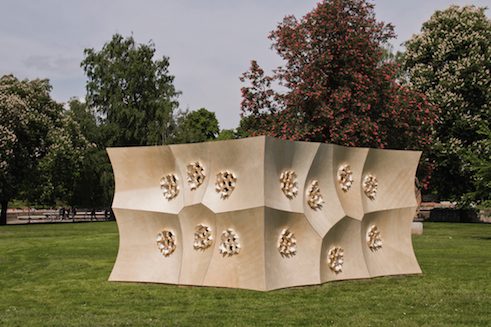 HygroSkin Pavillon | FRAC 2013 | Photo: ICD Universität Stuttgart
Frankfurt architect Achim Menges, professor of computer-based design at the University of Stuttgart, is another protagonist of such efforts. He too is searching for new building materials, for instance hydroscopically active materials that alter their form according to humidity. He built a pavilion in this fashion, whose facades open with sunshine and close with air moisture without engine power or observable material fatigue. He is currently developing a 3-D printing method with which one can synthetically produce such climate-reactive building components. Scarcely any limits are set to the imagination where applications for this mode of construction are concerned.
HygroSkin Pavillon | FRAC 2013 | Photo: ICD Universität Stuttgart
Frankfurt architect Achim Menges, professor of computer-based design at the University of Stuttgart, is another protagonist of such efforts. He too is searching for new building materials, for instance hydroscopically active materials that alter their form according to humidity. He built a pavilion in this fashion, whose facades open with sunshine and close with air moisture without engine power or observable material fatigue. He is currently developing a 3-D printing method with which one can synthetically produce such climate-reactive building components. Scarcely any limits are set to the imagination where applications for this mode of construction are concerned.
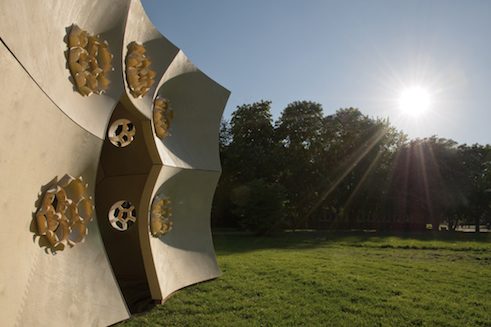 HygroSkin Pavillon | FRAC 2013 | Photo: ICD Universität Stuttgart
He is also at work on new ideas for timber construction, whose technical development is currently undergoing a quantum leap. At an exhibition pavilion at the Landesgartenschau /German National Horticultural Show 2014 in Schwäbisch Gmünd, he presented an unconventional prefab construction method inspired by sea urchins. Their endoskeleton reveals sophisticated linkages to the slab edges that were carried over into timber construction.
HygroSkin Pavillon | FRAC 2013 | Photo: ICD Universität Stuttgart
He is also at work on new ideas for timber construction, whose technical development is currently undergoing a quantum leap. At an exhibition pavilion at the Landesgartenschau /German National Horticultural Show 2014 in Schwäbisch Gmünd, he presented an unconventional prefab construction method inspired by sea urchins. Their endoskeleton reveals sophisticated linkages to the slab edges that were carried over into timber construction.
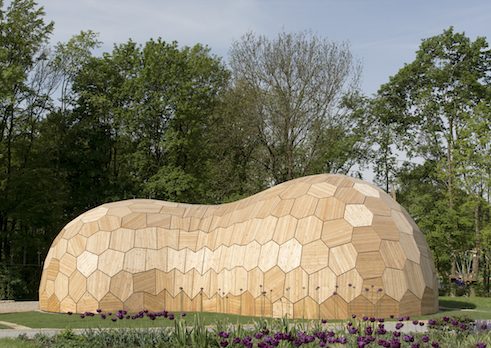 Pavillon Landesgartenschau Schwäbisch Gmünd 2014 | Photo: ICD/ITKE/IIGS Universität Stuttgart
The insight that nature is the best builder and learning from natural constructions and materials also derive from the 2015 deceased architect and engineer Frei Otto. Like the latter, Menges collaborates on an interdisciplinary basis with engineers, materials scientists, biologists and computer specialists.
Pavillon Landesgartenschau Schwäbisch Gmünd 2014 | Photo: ICD/ITKE/IIGS Universität Stuttgart
The insight that nature is the best builder and learning from natural constructions and materials also derive from the 2015 deceased architect and engineer Frei Otto. Like the latter, Menges collaborates on an interdisciplinary basis with engineers, materials scientists, biologists and computer specialists.
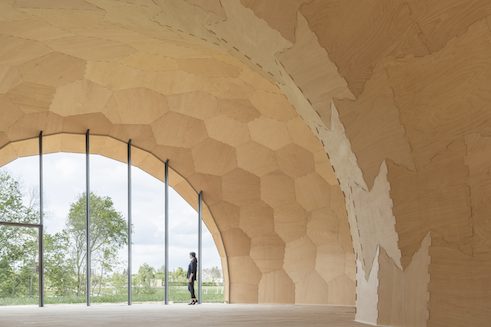 Pavillon Landesgartenschau Schwäbisch Gmünd 2014 | Photo: ICD/ITKE/IIGS Universität Stuttgart
The Elytra Filament Pavilion presented in 2016 in the courtyard of London’s Victoria and Albert Museum, is also reminiscent of Frei Otto’s string and wire models. In collaboration with Stuttgart engineer Jan Knippers, a structure arose that was oriented on the elytra (protectively hardened forewings) of insects. A robot wove them on frames, with soft glass-fibre yarn and extremely stiff carbon filter wires supplementing each other in terms of bearing capacity to form an extremely stable construct.
Pavillon Landesgartenschau Schwäbisch Gmünd 2014 | Photo: ICD/ITKE/IIGS Universität Stuttgart
The Elytra Filament Pavilion presented in 2016 in the courtyard of London’s Victoria and Albert Museum, is also reminiscent of Frei Otto’s string and wire models. In collaboration with Stuttgart engineer Jan Knippers, a structure arose that was oriented on the elytra (protectively hardened forewings) of insects. A robot wove them on frames, with soft glass-fibre yarn and extremely stiff carbon filter wires supplementing each other in terms of bearing capacity to form an extremely stable construct.
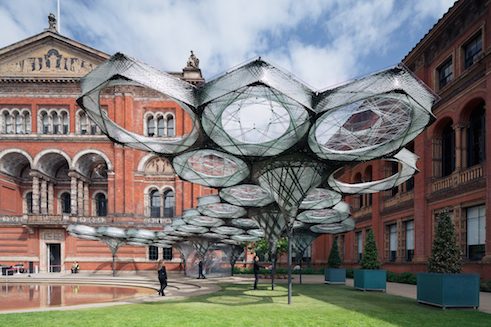 Elytra Filament Pavillon | Victoria and Albert Museum London | © ICD/ITKE | Photo: NAARO
Menges´ is also interested in computerised morphogenetic design methods, in other words computer-assisted form-finding like the computerised production of buildings, for instance by robots. Goals here are optimal exploitation of the performance-capability of materials, development of material-saving and sustainable building methods as well as simplification, acceleration and economisation of construction site management.
Elytra Filament Pavillon | Victoria and Albert Museum London | © ICD/ITKE | Photo: NAARO
Menges´ is also interested in computerised morphogenetic design methods, in other words computer-assisted form-finding like the computerised production of buildings, for instance by robots. Goals here are optimal exploitation of the performance-capability of materials, development of material-saving and sustainable building methods as well as simplification, acceleration and economisation of construction site management.
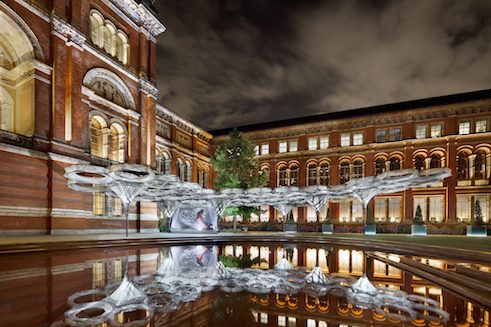 Elytra Filament Pavillon | Victoria and Albert Museum London | © ICD/ITKE | Photo: NAARO
Menges also sees his mission in the area of education, since the next generation of architects must be prepared for the fact that the key aspect of their activity, design, will change greatly. Thus the research pavilions whose purpose is to show how the new methods are expressed architecturally both at the design level and at the production level. As a side effect, these new building methods at the disposal of architects make possible fascinating aesthetic, almost poetic building art that casts its spell on every visitor.
Elytra Filament Pavillon | Victoria and Albert Museum London | © ICD/ITKE | Photo: NAARO
Menges also sees his mission in the area of education, since the next generation of architects must be prepared for the fact that the key aspect of their activity, design, will change greatly. Thus the research pavilions whose purpose is to show how the new methods are expressed architecturally both at the design level and at the production level. As a side effect, these new building methods at the disposal of architects make possible fascinating aesthetic, almost poetic building art that casts its spell on every visitor.
University researchers are continually opening up new pathways and possibilities for tomorrow’s construction. Now it is up to industry to make use of this potential by developing innovations to market maturity and expeditiously putting them into practice. But this, and the adaptation and establishment of relevant standards and regulations are still lacking.